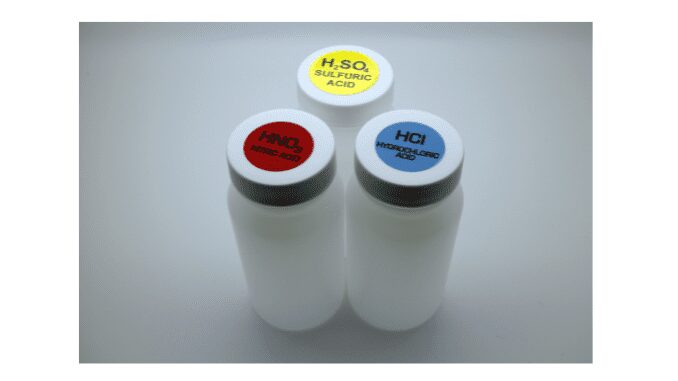
Introduction
Strong acids are substances that on dissociation release a vast number of hydronium cations ( H+or H3O+). Strong acids also have a large value for Ka (dissociation constant for acids). According to many scientists and the theories proposed by them, Strong acids are further described in numerous ways.
Theories for strong acids
1. Bronsted and Lowry’s theory
According to the theory given by scientists Bronsted and Lowry, acids are substances that donate H+ ions, and strong acids, on the other hand, donate a quite large number of H+ ions in their aqueous solution.
2. Arrhenius’s theory
According to Arrhenius, acids are substances that when introduced to water form an aqueous solution containing H+ ions.
Furthermore, if we talk about strong acids, these substances on dissociation release H+ ions in greater quantity which makes the solution a good conductor of electricity as well.
3. Lewi’s theory
Lewis’s theory of acid states that substances that accept pairs of electrons are acids. Or in other words, compounds that are electron deficient and tend to borrow from other compounds are acids.
Examples
Here are some examples of strong acids, also in the previous section we discussed various theories, some theories have limitations due to which they have specific examples justifying them. We will try to classify them accordingly.
Bronsted and Lowry’s strong acids
- HCl
- H2SO4
- HNO3
Arrhenius Strong acids
- HI
- HBr
- HClO4
Lewis Strong acids
- BBr3 (strongest lewis acid)
- SbF5
- BCl3
Some Popular reactions involving strong acids
1. HBr + H2SO4 → Br2 + SO2 + 2H2O
The above reaction involves two strong acids, namely hydrobromic acid, and sulphuric acid. In this reaction, the hydrogen atom from both HBr and H2SO4 gets released and then gets attracted toward the oxygens of SO4 –, forming H2O.
2. HBr + C3H6 → C3H7Br
This reaction is one of the popular methods to prepare haloalkanes. Haloalkanes are compounds containing halogens on an alkyl chain. HBr being a strong acid releases H+ ions, Br approaches the carbon center and breaks the alkene bond of the carbon chain. The hydrogen ion gets attached to the carbon according to Markonikov’s rule.
3. NaCl + H2SO4 → NaHSO4 + HCl
This reaction involving H2SO4 is a method to prepare HCl. This method includes NaCl which loses Cl– ion, and this Cl– accepts hydrogen ion which is released from H2SO4.
4. NaClO4 + HCl → NaCl + HClO4
The above reaction consists of HCl using which we prepare HClO4, both of them are strong acids and hence make this reaction significant in itself, as from one strong acid another is prepared.
5. Mg + HNO3 → Mg(NO3)2 + H2
HNO3 is a strong acid and when it reacts with metals like magnesium, the products are metal salt and hydrogen gas is released as well.
Example Problems
1. What are strong acids?
They are substances that get completely ionized in their aqueous solution. The value of the dissociation constant for these substances is very high.
2. What are the different theories about acids and bases?
There are 3 theories popularly known:
- Bornsted and Lowry’s Theory
- Arrhenius’s Theory
- Lewis’s Theory of acid and bases.
3. Explain the mechanism of reaction: HBr + C3H6 → C3H7Br.
The reaction between hydrobromic acid and alkene is a method of preparation for haloalkanes. The reaction follows Markovnikov’s rule. According to it, in this reaction, the hydrogen atom gets attached to the carbon which has more alpha hydrogen or which is the negative member during the reaction.
4. What are the characteristics of strong acids?
Some characteristics are
- React with active metals to produce hydrogen.
- It turns the Universal color indicator to red.
- Strong acids with strong bases produce salt and water.
- They are also responsible for some severe types of corrosion.
5. What happens with copper when it is reacted with nitric acid?
Copper has a very unreactive tendency due to which it does not easily react with dilute acids, but nitric acid, on the other hand, is a strong oxidizing agent due to which it oxidizes copper and slowly the whole sample of copper is dissolved in the nitric acid solution.
6. Which acid is said to be the “King of acids”?
Sulphuric acid (H2SO4) is called the king of acids, and apart from it Sulphuric acid is also popularly known as the King Of Chemicals, this is because it is highly reactive and can even dissolve other acids or chemicals in it.
Written By: Bharat Awasthi
